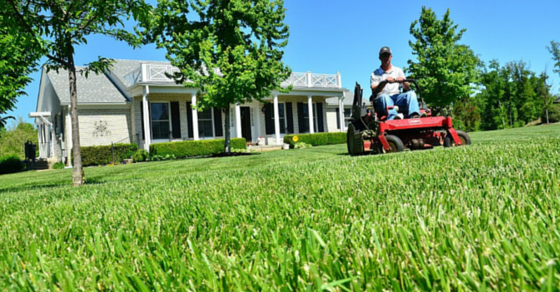Spring is a time that many homeowners focus on annuals, perennials and landscaping, but don’t forget about a major part of your home’s curb appeal – your grass! Having a lush, green lawn is a pride for many homeowners – but it does require some work and regular maintenance. Here are a few DIY lawn care tips for achieving a greener, healthier lawn.
Mow at the Highest Acceptable Height
One of the most common lawn care mistakes is mowing the lawn way too short. Longer grass blades mean deeper roots. Grass with deeper roots is more likely to withstand drought and fight off pests and disease. Mowing your grass at a shorter height does not mean you’ll get to mow less.
Give It a Drink
Deep, rather than shallow, watering encourages roots to grow deeper, so water deeply about once a week. A half-inch to one inch of water to 12 inches of soil is a good ratio for actively growing grass. Don’t know how long it takes your sprinkler to disperse that much water? It could take between 15 and 30 minutes depending on your sprinkler type. Use a rain gauge while running your sprinkler to see how long it takes to reach one inch.
Water at the Right Time
Avoid watering during the hottest part of the day, typically from 11 a.m. to 3 p.m. The optimal time to water is between 6 and 10 a.m., because there is less wind, less hot sun and your lawn has longer to dry. Watering at night gives the chance for mildew and fungus to form, so if you can’t water in the morning, aim for sometime between 4 and 7 p.m.
Sharpen Your Blades
Though they may get the job done, dull mower blades tear off grass rather than cutting it, which leaves ragged tips susceptible to disease. During the growing season, sharpen your mower blade after you’ve used the mower for approximately 8-12 hours.
Feed Your Lawn
Even if your grass is healthy, it still needs fertilization. Most experts recommend fertilizing twice a year in the spring and fall for the minimum. Look for a fertilizer complete with micronutrients such as sulfur, copper and iron.
For an even better idea of what your lawn needs from a fertilizer, have your soil tested for pH and the quantity and availability of nutrients. Typically home kits only test pH, so contact a cooperative extension service to conduct the test.
Confront Weeds, Insects and Diseased Grass
If your lawn has brown circles or dry areas, you may have an underlying problem, literally and figuratively. Big circles, called brownouts, are often caused by fungal diseases or an insect infestation.
Time to Aerate
When grass becomes too compacted, nutrients are unable to penetrate to the root where they’re most beneficial. That’s when it’s time to improve your lawn’s oxygen circulation by aerating. For the best aeration, use a core aerator which pulls actual plugs from the soil. Many riding mowers come with core aerators attachments. If you’re looking to aerate a small area, a digging fork will do the trick. After aeration is a great time to fertilize, as well.
For more lawn care and homeowner tips, follow Compass on Pinterest.
